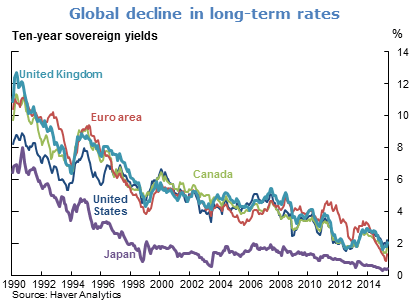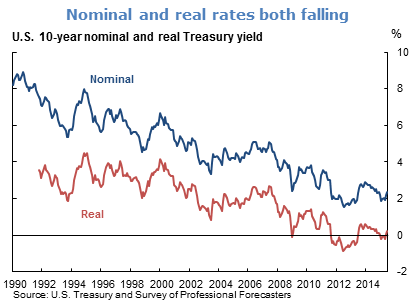Michael Bauer, senior economist at the Federal Reserve Bank of San Francisco, states his views on the current economy and the outlook.
- Revised estimates indicate that real GDP rose by 0.7% at an annualized rate in the first quarter of 2015, wiping out the previously reported contraction. A first estimate of 2.3% growth in the second quarter is consistent with an ongoing moderate expansion of the U.S. economy, confirming that the first-quarter weakness was largely due to transitory factors.
- We expect the U.S. economy to grow slightly above its 2% long-term trend for the next four quarters, and then return to trend by the end of 2016. Positive fundamentals include both rising asset prices, which bolster wealth and balance sheets, and a strengthening labor market, which supports household income and consumer spending. However, the stronger dollar over the past year constitutes a headwind for net exports and a drag on growth. Uncertain economic conditions abroad, including in China and Europe, pose some risks to this outlook, but overall we view upside and downside risks as roughly balanced.
- Labor market conditions have continued to improve, and the economy is nearing full employment. Job growth has been strong and consistent, jobless claims are near a 40-year low, and the unemployment rate of 5.3% in July indicates that there is very little slack in labor markets. While significant growth in wages and compensation has yet to appear, we expect a pickup in wage growth as labor markets tighten further.
- Inflation remains below the Federal Open Market Committee’s 2% long-run target. We may see some further weakness in overall inflation in the second half of the year due to lower oil prices and a stronger dollar. However, we expect inflation to gradually move back to the target over the medium term as energy prices and the value of the dollar stabilize or reverse direction and as the slack in product and labor markets diminishes.
- Financial conditions have modestly tightened in the first half of this year, as evidenced by a stronger dollar, modestly wider credit spreads, and more volatile global equity prices. However, overall they remain very supportive of aggregate demand and should continue to positively affect economic growth.
- U.S. long-term interest rates have fallen over the past 30 years and are near historic lows. Three facts stand out about this secular decline: First, it has been a global phenomenon, as the decline in the United States was paralleled by a similar trend in most developed countries. Second, the decline was largely unexpected, and forecasters consistently overestimated the future level of interest rates at various points in the past. Third, the decline was evident not only in nominal interest rates but also, and more importantly, in real (that is, inflation-adjusted) interest rates, which drive saving and investment decisions.
- Structural long-lived changes in the world economy have played an important role in this decline in long-term interest rates. In particular, trend growth of output and productivity has markedly slowed in developed countries—the phenomenon of so-called secular stagnation—which has reduced investment demand. Also, the global saving glut, mostly due to fast-growing emerging market economies with excess saving due to large trade surpluses, has exerted downward pressure on real interest rates. Another important contributing structural factor is the shortage of “safe” assets, such as high-quality government securities, the supply of which is failing to keep up with strong global demand.
- Cyclical, transitory factors are also keeping long-term interest rates down. In particular, easy monetary policy in developed countries, implemented through low policy rates and quantitative easing, has kept short-term and long-term interest rates low. In addition, uncertainty surrounding the ongoing euro-area crisis and other related risks has led to precautionary savings and flight-to-safety demand. Finally, deleveraging by households and firms in the aftermath of the financial crisis in order to reduce their debt levels and improve their balance sheets has contributed to the global supply of savings.
- The eventual reversal of the cyclical factors affecting investment and saving in financial markets should lead to some normalization of long-term interest rates. However, the structural factors are not expected to change rapidly. Hence, there is likely to be a new normal for long-term real rates, which will be different—and lower—than in the past.
- In such an environment, borrowers would benefit from lower interest rates. On the other hand, savers seeking higher returns may take on more risk. A low interest rate environment would also give less potential room for monetary policy to stimulate economic growth through policy rate changes. In sum, lower real interest rates involve both benefits and risks.







The views expressed are those of the author, with input from the forecasting staff of the Federal Reserve Bank of San Francisco. They are not intended to represent the views of others within the Bank or within the Federal Reserve System. FedViews appears eight times a year, generally around the middle of the month. Please send editorial comments to Research Library.
